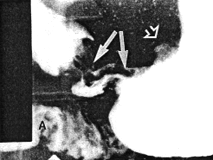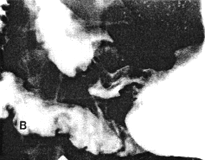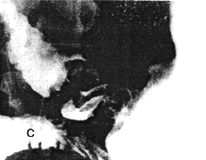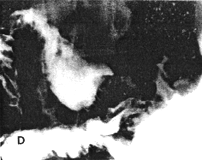



Go to chapter: 1 | 2 | 3 | 4 | 5 | 6 | 7 | 8 | 9 | 10 | 11 | 12 | 13 | 14 | 15 | 16 | 17 | 18 | 19 | 20 | 21 | 22 | 23 | 24 | 25 | 26 | 27 | 28 | 29 | 30 | 31 | 32 | 33 | 34 | 35 | 36 | 37 | 38 | 39
Chapter 29 (page 143)
Chronic Benign Gastric Ulceration
Many authors found evidence of chronic or atrophic gastritis in the pyloric region in
cases where gastric ulceration was located more proximally in the stomach (Lilja l959;
Burge et al. l963; du Plessis l963; Schrager et al. l967; Gear et al. l97l; Lawson l972;
Meister et al. l979). Some investigators looked upon "antral" gastritis as the primary
event (Schrager et al. l967; Gear et al. l97l), while others pointed out that the relationship
between gastritis and gastric ulceration remained controversial (Lawson l972;
Liebermann-Meffert and Allgöwer 1977).
Narrowing of the pyloric region in cases of chronic, benign gastric ulceration in the
region of the angulus has been described by several authors. Steigman (l943) for
instance, noted "antral spasm" in a small percentage of cases where the ulcer was located
at the incisura angularis. Lilja (l953, l954) found the canalis egestorius (i.e. the pyloric
sphincteric cylinder) to be contracted in some of these cases of gastric ulceration. The
cylindrical contraction might resemble AHPS, or it might be less severe and be more in
the nature of an impairment of motility; irregular and oblique mucosal folds might be
present in the contracted region, and the pylorus might be patent. Burge et al. (l963)
called the condition the "pyloric channel syndrome", while Schrager et al (l967) termed it
"stenosis of the antrum".
Motility disturbances of the pyloric region in cases of gastric ulceration of the corpus
were described by Garret et al. (l966) during manometric studies, by Kwong et al. (l970)
during myoelectrical investigations and by Miller et al. (l980) in gastric emptying studies.
One case in which AHPS was associated with a gastric ulcer located 6.0cm proximal to
the pylorus was described by Skoryna et al. (l959), and another by Knight (l96l) (Chap.
24); the latter author considered AHPS to be the cause of the ulcer. According to
Liebermann-Meffert and Allgöwer (l977) nodular or fusiform thickening in the
pyloric and prepyloric musculature, with mucosal and submucosal changes, reduction in
the number of Auerbach's plexuses and fibrosis, occurred not uncommonly in association
with gastric ulceration more proximally in the stomach; these alterations caused a
disturbance of normal motility and of the "antral pump mechanism".
The cases described here show that a chronic, benign gastric ulcer, situated away from
(i.e. orally to) the pyloric region, may be associated with contraction of the pyloric
sphincteric cylinder. In a recent series of 65 consecutive cases of chronic gastric
ulceration, where the ulcer was located more proximally in the stomach (usually in the
region of the angulus on or near the lesser curvature), we noted a constant contraction of
the pyloric sphincteric cylinder in 10. (Comment: Although histology of the
ulcer was obtained in all instances, microscopic examination of the pyloric region was
not considered to be a routine examination and was not done). This confirms the findings
of Lilja (l953, l954), and will probably also explain some of the appearances described by
Steigmann (l943), Schrager et al. (l967), and others.
Contraction of the pyloric sphincteric cylinder may be associated with increased
duodenogastric reflux (Chap. 27), fixation of the pyloric aperture in the "open" position
(Chap. 20), decreased cyclical activity (Chap. 20), delayed emptying of solids (Chap. 18)
and diminished trituration (Chap. 18). Among the abnormalities encountered in patients
with gastric ulceration in the corpus of the stomach, Brooks (l985) mentioned increased
bile reflux, incompetent pylorus, reduced amplitude of gastric "antral" contractions and
delayed gastric emptying of solids. It appears possible that contraction of the pyloric
sphincteric cylinder may be a factor in the pathophysiology of these cases.
Why some cases of ulceration in the gastric corpus should be associated with contraction
of the pyloric sphincteric cylinder and others not, is not known. It is not clear whether
gastric ulceration or contraction of the cylinder is the primary event. We have not been
able to establish a clear relationship between the size, chronicity or exact situation of the
ulcer on the one hand, and contraction of the cylinder on the other.
Malignant Gastric Ulcer
Contraction of the pyloric sphincteric cylinder in the presence of an ulcer in the corpus
does not necessarily indicate a benign ulcer. During the present investigation the
following case, proving the opposite, was encountered.
Case Report
Case 29.4 F.F., 29 year old female, presented with epigastric pain and loss of weight.
Radiographic examination showed an ulcer 1.5 cm in diameter on the lesser curvature of
the stomach at the incisura angularis (Fig. 29.4 (A-D). A cylindrical
contraction, 3.0 cm in length and containing a longitudinal mucosal fold, was seen in the
pyloric region; a prominent pseudo-diverticulum was evident on the greater curvature
side of the contraction, the appearances tallying with contraction of the pyloric
sphincteric cylinder. Occasionally a minor degree of relaxation occurred, but most of the
time the contraction remained as illustrated, with absence of normal cyclical activity.
(Fig. 29.4 A-D). Response to anti-ulcer therapy was poor. Endoscopic
biopsy 6 months later showed an ulcer at the angulus with surrounding induration.
Microscopically the base of the ulcer consisted of fibrinopurulent material, fibrotic tissue
and well-differentiated adenocarcinoma cells. Billroth II partial gastrectomy confirmed
the large ulcer with indurated edges on the lesser curvature. Microscopically a well-
differentiated adenocarcinoma, infiltrating locally through the muscularis externa into the
subserosal tissue, was seen. The adjacent gastric mucosa showed areas of intestinal
metaplasia. Microscopic examination of l7 lymph nodes revealed no carcinoma cells. It
was concluded that the appearance of a chronic ulcer with dense fibro-collagenous tissue
and carcinoma cells in the base, was compatible with so-called "ulcer cancer", i.e.
carcinoma originating in a chronic gastric ulcer.
 |  |
 |  |
| Fig. 29.4 A-D
Case F.F. Malignant ulcer at incisura angularis (open arrow). Constant contraction of pyloric
sphincteric cylinder with absent cyclical activity (filled arrows)
|
Previous Page | Table of Contents | Next Page
© Copyright PLiG 1998










